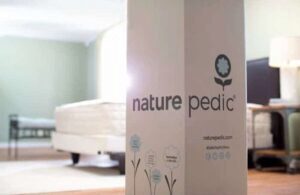Is Mattress Off-Gassing Dangerous?
Disclosure: By clicking on the product links in this article, Mattress Nerd may receive a commission fee at no cost to you, the reader. Read full disclosure statement.
When you purchase a new mattress, especially one made of memory foam, you may notice an unusual “new mattress smell” (similar to a new car smell) once you pull it out of the box. This is the result of a process called “off-gassing,” which may sound concerning, but with the right information you can protect yourself from its effects. In this article, you’ll find out more about what mattress off-gassing is and what you can do to mitigate its impact on your home, your health, and the environment.
What is Mattress Off-Gassing?
The first thing to review is what mattress off-gassing is exactly. Off-gassing is the process in which volatile organic compounds (also known as VOCs) break down, resulting in them emitting certain gases and vapors. You can find VOCs in many manufactured household products, such as cleaners, air fresheners, and paint. In memory foam mattresses, you’ll notice a variety of materials that can off-gas, including benzene, methylene, and more. Also, there are VOCs used in flame retardants that are included in mattress manufacturing as well.
Some additional VOCs that may be present in memory foam mattresses include:
Chlorofluorocarbons and CFCs: non-toxic chemicals that are usually found in packing and refrigeration.
Toluene: a solvent used in making adhesives.
Trichloroethane: a compound also used as a solvent, but sometimes found in oil cleaners and inks as well.
Perfluorocarbon PFCs: non-toxic organic compounds that are used in solvents and also oxygen tanks.
Naphthalene: a chemical compound used for synthetic fibers inside foams and certain plastics.
Formaldehyde: a natural compound that is typically used for paper products and for preservation. This can be a significant factor in the notorious off-gassing odors.
What are the Effects of Off-Gassing?
Prolonged exposure to off-gassing can impact your overall health, but the extent of the impact depends on the concentration of the VOCs in the air, the type of VOCs you’re exposed to, and the length of time at which you’re exposed. In extreme cases, VOCs can contain carcinogens and other harmful chemicals that can cause significant health effects to your organs and central nervous system.
Fortunately, VOCs found in memory foam mattresses are at very low levels and are not extremely toxic or dangerous, thanks in part to CertiPUR-US, an organization committed to overseeing VOCs in mattress manufacturing.
If you happen to be subjected to VOC exposure, you may experience some minor symptoms or health problems, including throat irritation, eye irritation, nausea, headaches, and slight breathing problems. These symptoms typically go away once you’re not near the mattress or it’s fully aired out.
Aside from personal health issues, VOC emissions and off-gassing can also cause problems for the environment. Again, this may be minimal compared to other VOC emitters around the home, but it’s still an important factor to consider while shopping for your new mattress.
Can Off-Gassing be Prevented?
Off-gassing is a naturally-occurring reaction due to VOCs being emitted from the mattress. While it can’t be completely prevented, you can still minimize their impact on you, your indoor air quality, and the environment. Here are several steps you can take.
Proper Ventilation
When you purchase your new memory foam mattress, the first thing you should do is provide proper ventilation. As soon as you unbox it, leave it in a well-ventilated room or outside for at least two days. If you have time, you can even use a full week to air it out, ensuring it’s fully off-gassed and free from chemical odors. Make sure that you leave it in a spot where there is a good cross-breeze and where it won’t get wet.
Although most VOCs are typically emitted within the first hour of unboxing, they can continue for several days after. It’s recommended that, after the initial air-out period, you still keep your bedroom windows open for a few days to make certain the new mattress is fully ventilated and can off-gas with minimal effect on your health and well-being.
Mattress Materials
Memory foam mattresses are usually the biggest culprits when it comes to off-gassing, but they’re not the only ones that can exhibit this process. In fact, many popular mattress types off-gas to a different extent.
Polyfoam
Polyurethane foam consists partly of memory foam, so mattresses made of this material may experience some off-gassing. Compared to complete memory foam mattresses, you’ll find that PolyFoam is a better route for avoiding the effects of off-gassing, but there are still better options to consider.
Natural Latex
Latex mattresses are usually all-natural, made from materials harvested from the rubber tree, so off-gassing is virtually non-existent. Even if the latex comes from a synthetic source, it is still unlikely to emit harmful gasses, ultimately providing a much better, non-toxic mattress option compared to the off-gassing from memory foam and PolyFoam.
Innerspring
Older innerspring mattresses that don’t consist of memory foam are less likely to off-gas. Nowadays, though, you’ll find many innerspring mattresses have a comfort layer or support layer of memory foam or PolyFoam, which will slightly off-gas, but overall, it won’t be near the levels of a pure memory foam mattress.
Other Natural Materials
Mattresses made from other natural materials, such as bamboo or organic cotton, typically utilize very little VOCs in their manufacturing process, but they are also usually much more costly. If off-gassing is a major concern for you, then organic mattresses may be the best mattress option.
Certipur-US Certified Foam
As mentioned previously, CertiPUR-US is an organization that keeps an eye on VOCs and other materials used in mattress construction to minimize the impact they have on the environment and our health. When shopping for a mattress, it’s advised that you look for CertiPUR-US certified foams, which follow a strict set of guidelines to make them as safe and non-toxic as possible. CertiPUR-US certified foams are made without toxic chemicals; ozone depleters; PBDEs, TDCPPs, TCEP flame retardants; heavy metals like mercury or lead; formaldehyde; and other potentially harmful chemicals such as phthalates.
Summary
The concept of off-gassing may be concerning for many, but you can rest assured knowing that the levels of VOCs emitted from most mattresses are not harmful enough to cause significant harm to you. However, if you want to avoid that chemical smell and those off-gassing odors that cause headaches and slight breathing problems, these tips should help you find an alternative mattress option. If you’re interested, head over to our lists of the best organic mattresses and best latex mattresses.


